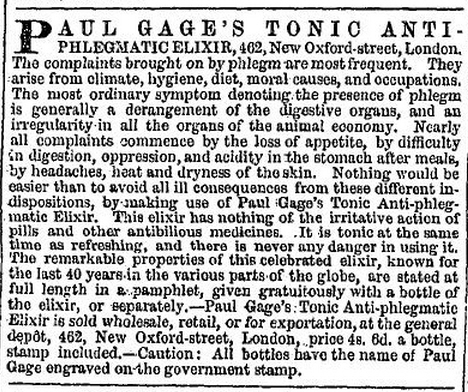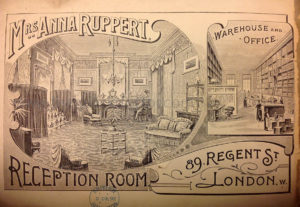 Source: The Liverpool Mercury, 30 December 1851
Source: The Liverpool Mercury, 30 December 1851
.
Phlegm is generally white, greyish, or of a yellow colour, with streaks of black; its consistency varies from the limpidity of water to the thickness of jelly.
This vivid description is from Parisian chemist Paul Gage’s Treatise on the Effect and Disorders produced by Phlegm in the Human Frame – the pamphlet referred to in the advert above. The 16-page essay is elegantly written and, rather than trumpeting the medicine’s properties in the exaggerated fashion typical of quacks, Gage uses more sophisticated tactics to persuade the reader of its efficacy.
Phlegm, Gage believed, was implicated in virtually all diseases – the sheer amount of the stuff was evidence for this. He estimated that if all the phlegm in the human body were collected together, the quantity would ‘surpass the weight of all other evacuations.’ Medical men might argue over this, but they were too inclined to follow fashions in diagnosis and put their own opinions above the welfare of their patients. Gage uses the common quack ploy of discrediting the medical profession, politely accusing them of disagreeing amongst themselves, observing only what they wished to observe and ignoring ancient systems of medicine.
At the time of the Treatise’s publication in English (1851), disorders of the blood were the ‘in thing’ and according to Gage, doctors did not look much beyond blood-letting as a treatment. Drawing of bad blood, however, was useless as it would simply be replaced by more bad blood if the cause – that is, the phlegm – were not removed.
‘For heaven’s sake,’ appealed Gage, ‘overcome the principle before attempting to overcome the symptom.’
At the other end of the spectrum was the ‘enlightened medical man who has at heart the love of his suffering fellow creatures’ – i.e. Monsieur Gage himself. He pre-empts criticism by pointing out the medical establishment’s tendency to write off any new method as quackery in order to protect their own interests.
It was easy to tell if you were suffering from phlegm: the ‘abundant expectoration of clear and slimy mucus’ was a bit of a giveaway. Other symptoms, however, included dry skin, belching, pale lips, hoarseness and poor digestion. Women and children were the greatest sufferers but phlegm affected everybody – particularly those of weak constitution, sorrowful and melancholy temperament and a sedentary lifestyle.
The Antiphlegmatic Elixir was a laxative, which seems odd for a condition now associated with the respiratory tract, but to Gage phlegm was just as much of a problem in the digestive system. In children, for example, it could generate and nourish intestinal worms. When treated with the Elixir (in conjunction with a decoction of male fern – a standard vermifuge!), the creatures would come out surrounded by masses of the stuff.
As well as worms and the more likely coughs, colds and asthma, the Elixir would cure apoplexy, scrofula, gout, dropsy, palpitations, skin conditions and ‘diseases of women.’
The Treatise contains a list of successful cases, but in a departure from the common quack practice of printing testimonials in the patients’ own words, Gage sets his out in the third person, like the case histories in reputable medical books.
One featured patient was a 28-year-old lady with five children, who had numerous crevices in her right breast and a white swelling on her right elbow. Until the age of 25 she had thrown up large quantities of viscous matter every morning, and when her mother mentioned this to the attending physician, he prescribed the Antiphlegmatic Elixir. After five months the lady was cured.
By writing of a reputable doctor prescribing the Elixir, and giving a lengthy recovery period rather than a miraculous instant cure, Gage subtly dissociated himself from quackery and presented his ideas as equal in status with (but more enlightened than) medical orthodoxy. He appealed to the educated reader with a sense of responsibility for their own health, and in doing so trousered a similarly upmarket 4s. 6d. per bottle.
.
.


